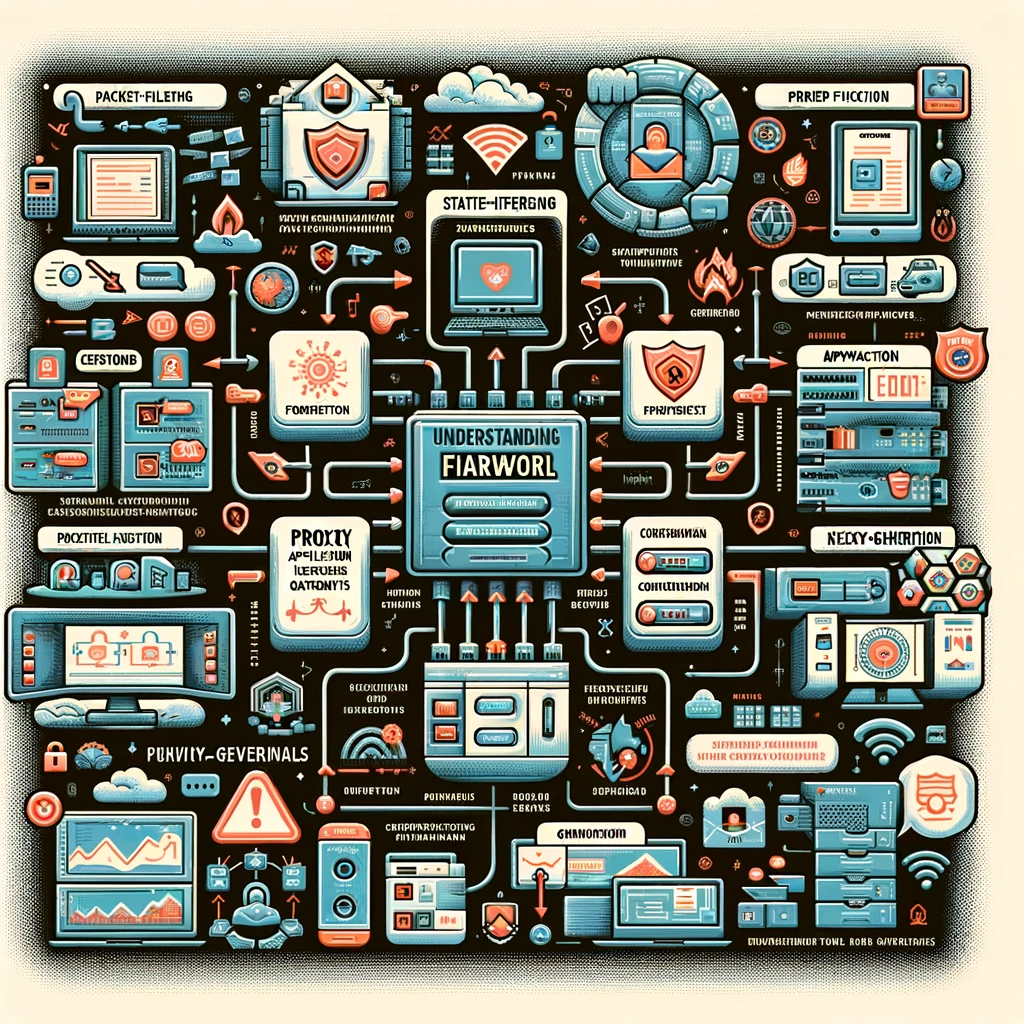Table of Contents
Understanding Firewalls – Types, Functions, and Configurations
Firewalls serve as a fundamental component in the framework of network security, acting as a barrier between secure internal networks and untrusted external networks, such as the internet. A firewall’s primary function is to control the flow of traffic based on an organization’s set of rules, preventing unauthorized access while allowing legitimate communication. This blog post delves into the intricacies of firewalls, exploring their types, functions, and configurations in detail.

Types of Firewalls
Packet-Filtering Firewalls: These are the most basic form of firewalls. They operate at the network layer and make decisions to allow or block traffic based on source IP address, destination IP address, TCP/UDP source and destination ports, and the protocol used. Their simplicity means they are fast and efficient but lack the ability to perform deep packet inspection.
Stateful Inspection Firewalls: Advancing from packet-filtering technology, stateful inspection firewalls, also operating at the network layer, keep track of active connections and make decisions based on the state of these connections. They monitor the entire communication path and context of a packet, not just the headers, which enhances security but requires more processing power.
Proxy Firewalls (Application-Level Gateways): These firewalls operate at the application layer, acting as an intermediary between users and the external servers they wish to access. By intercepting all messages entering and leaving the network, they can filter out unwanted content, hide IP addresses, and provide a high level of security. However, this can lead to slower traffic flow.
Next-Generation Firewalls (NGFWs): NGFWs combine the capabilities of the aforementioned firewalls with additional features like deep packet inspection, intrusion prevention systems (IPS), and the ability to identify and block malicious traffic based on application-level inspection. They are designed to address the evolving sophistication of cyber threats.
Cloud Firewalls (Firewall as a Service): These are hosted in the cloud and provide a scalable, flexible security solution that is particularly beneficial for businesses adopting cloud services. Cloud firewalls simplify administration and ensure consistent policy enforcement across an organization’s entire network.
Functions of Firewalls
Traffic Control: Firewalls scrutinize incoming and outgoing network traffic based on an organization’s policy, permitting or blocking data packets accordingly.
Protection from Cyber Threats: By filtering out unauthorized access and potential threats, firewalls protect the network from various attacks such as viruses, worms, and hacking attempts.
Privacy: Firewalls can provide privacy to users by hiding internal IP addresses through Network Address Translation (NAT).
Logging and Reporting: They log traffic data and security events, providing valuable information for auditing, troubleshooting, and improving security policies.
Configurations
Configuring a firewall is a critical task that requires a deep understanding of network security principles and the specific needs of the network it protects. Here are key considerations in firewall configurations: Defining Security Policies: Before configuring a firewall, it’s essential to define comprehensive security policies that include rules for inbound and outbound traffic, ensuring that only legitimate traffic is allowed.
Establishing Zones and Segments: For enhanced security, networks can be divided into zones (e.g., DMZ, internal network, external network) with specific rules governing traffic between these zones.
Configuring Firewall Rules: This involves specifying the conditions under which traffic is allowed or blocked. Rules can be based on IP addresses, ports, protocols, and applications. It’s crucial to order these rules correctly; typically, more specific rules are placed higher in the list than general rules.
Setting up Intrusion Prevention/Detection Systems (IPS/IDS): Many firewalls now include IPS/IDS features. Configuring these can help identify and block potential threats based on known signatures and abnormal traffic patterns.
Implementing VPNs: For secure remote access, firewalls can be configured to establish Virtual Private Networks (VPNs), encrypting data and ensuring that remote communications are secure.
Regular Updates and Maintenance: Keeping the firewall’s firmware and software updated is crucial to protect against the latest vulnerabilities and threats.
In conclusion
firewalls are a critical element of network security, offering protection against a wide array of cyber threats. Understanding the different types of firewalls, their functions, and how to configure them effectively is essential for securing a network’s perimeter and safeguarding data. As cyber threats evolve, so too must firewall technologies and the strategies employed to manage and configure them, ensuring robust defense mechanisms are in place to protect valuable IT assets.
Go Home
